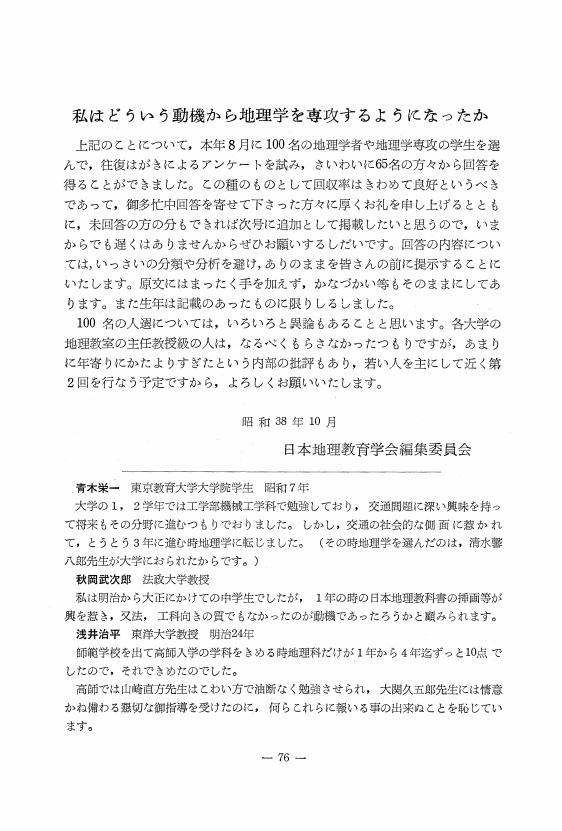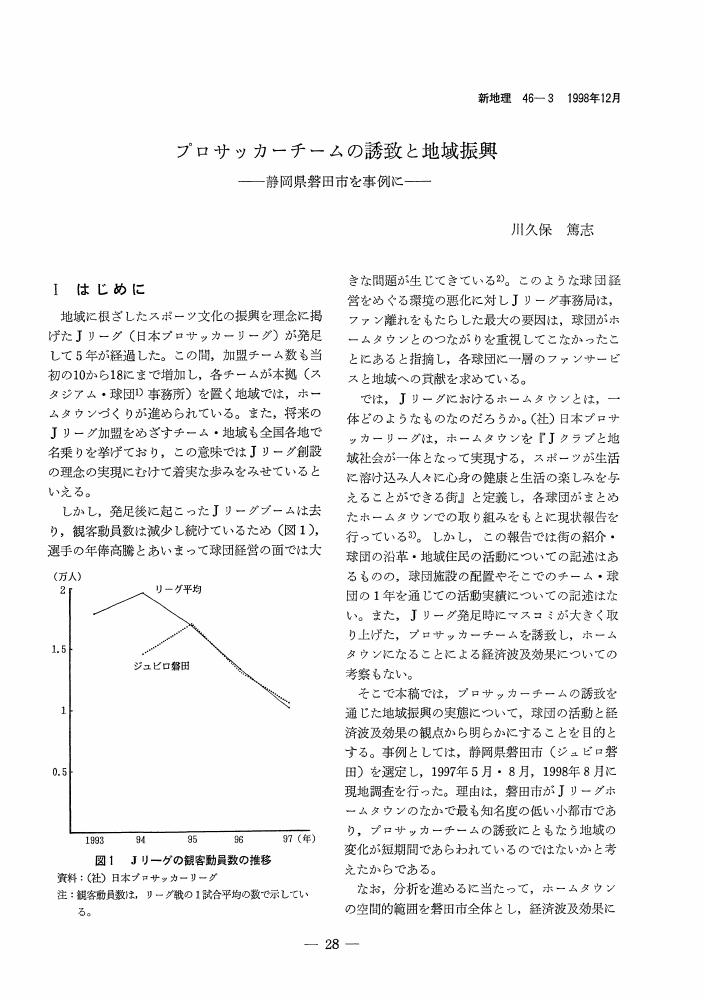3 0 0 0 OA 九十九里浜における観光開発と地域の変客
- 著者
- 関 信夫
- 出版者
- 日本地理教育学会
- 雑誌
- 新地理 (ISSN:05598362)
- 巻号頁・発行日
- vol.24, no.2, pp.13-42, 1976-09-25 (Released:2010-02-26)
- 参考文献数
- 28
3 0 0 0 OA わが国における郷土教育の系譜に関する研究
3 0 0 0 プロサッカーチームの誘致と地域振興:静岡県磐田市を事例に
- 著者
- 川久保 篤志
- 出版者
- The Geographic Education Society of Japan
- 雑誌
- 新地理 (ISSN:05598362)
- 巻号頁・発行日
- vol.46, no.3, pp.28-39, 1998
3 0 0 0 大阪市生野区におけるハングル表記の空間的特徴
- 著者
- 堀本 雅章
- 出版者
- The Geographic Education Society of Japan
- 雑誌
- 新地理 (ISSN:05598362)
- 巻号頁・発行日
- vol.54, no.3, pp.51-63, 2006
- 被引用文献数
- 1
2 0 0 0 OA 私はどういう動機から地理学を専攻するようになったか
- 著者
- 日本地理教育学会編集委員会
- 出版者
- 日本地理教育学会
- 雑誌
- 新地理 (ISSN:05598362)
- 巻号頁・発行日
- vol.11, no.2, pp.76-86, 1963-09-25 (Released:2010-02-26)
2 0 0 0 OA 地形教育のための空撮全天球画像を用いた教材の開発と評価
2 0 0 0 OA 伊豆大島三原山観光乗馬業
- 著者
- 木山 高美
- 出版者
- 日本地理教育学会
- 雑誌
- 新地理 (ISSN:05598362)
- 巻号頁・発行日
- vol.23, no.1, pp.24-30, 1975-06-25 (Released:2010-02-26)
2 0 0 0 OA 地理教育における地域学習の位置 -子どもたちの地域学習体験からの逆照射-
- 著者
- 竹内 裕一
- 出版者
- 日本地理教育学会
- 雑誌
- 新地理 (ISSN:05598362)
- 巻号頁・発行日
- vol.67, no.1, pp.1-12, 2019 (Released:2020-02-05)
- 参考文献数
- 17
2 0 0 0 OA 中学生の世界認識の実態に関する研究
- 著者
- 蓮池 理之
- 出版者
- 日本地理教育学会
- 雑誌
- 新地理 (ISSN:05598362)
- 巻号頁・発行日
- vol.66, no.1, pp.20-37, 2018 (Released:2019-06-04)
- 参考文献数
- 16
2 0 0 0 OA 地理院地図を活用した水害リスクと持続可能な地域づくりを 考察する授業展開およびその効果
- 著者
- 髙橋 裕
- 出版者
- 日本地理教育学会
- 雑誌
- 新地理 (ISSN:05598362)
- 巻号頁・発行日
- vol.69, no.2, pp.69-81, 2021 (Released:2022-04-17)
- 参考文献数
- 13
2 0 0 0 OA 東アジア地域における国名・地名の特徴 高等学校地理学習への活用
- 著者
- 室谷 茂
- 出版者
- 日本地理教育学会
- 雑誌
- 新地理 (ISSN:05598362)
- 巻号頁・発行日
- vol.54, no.4, pp.1-18, 2007-03-25 (Released:2010-04-30)
- 参考文献数
- 51
2 0 0 0 OA 「生徒に提示するGIS教材」による地形図の読図支援 「大学入試問題演習」での利用事例
- 著者
- 伊藤 智章
- 出版者
- 日本地理教育学会
- 雑誌
- 新地理 (ISSN:05598362)
- 巻号頁・発行日
- vol.52, no.4, pp.32-43, 2005-03-25 (Released:2010-04-30)
- 参考文献数
- 7
- 被引用文献数
- 2 2
This report is a practice record of high school geography class with using GIS (Geographic Information System). Today, GIS does not become a popular tool in Japanese geography class. The reasons, the author points out, are two problems. First, many high school teachers think that GIS does not fit their geographical exercise for college examinations Second, a GIS software is not easy for students. When the teachers teach geography with GIS, they have to teach about software more about geographical subjects. The teachers who do not use GIS not so more tend to think that GIS is not useful tool for their classroom. The author tried to make a practice to solve these problems.The author showed students how to solve a “Center test”, or a simultaneously test for college entrance examination asked by public examination center, with a diagram which was drawn by GIS software, “Kashmir”. It is well known software among Japanese mountain lover. Not only processing digitalized topographical data, drawing a bird's view diagram for example, but also searching Japanese topographical map from an Internet service. The teacher could comment smoothly with showing online map and bird's view diagram. Students understood about how to solve the tests more.Today, we can get the map and data from an internet. But if students use the data with each own computer, it is very difficult to understand more. In this case, the teacher is just showing the diagram made by GIS. The author believes that the teachers have to use GIS more easily.
2 0 0 0 大正・昭和戦前期における自動車の普及過程
- 著者
- 奥井 正俊
- 出版者
- 日本地理教育学会
- 雑誌
- 新地理 (ISSN:05598362)
- 巻号頁・発行日
- vol.36, no.3, pp.30-38, 1988
- 被引用文献数
- 2
The present paper attempts to clarify the diffusion process of automobiles which had appeared on the Japanese road traffic as modern transport facility, during the <i>Taisho</i> and the pre-war <i>Showa</i> periods (1912-1937). Main findings are summarized as follows:<br>In Japan there were only 535 automobiles in 1912. The number of automobiles had gradually increased since then (Fig. 1). Particularly since automobiles showed great convenience at the reconstruction works just after the severe earthquake hitting the Kanto district in 1923, the number of automobiles had increased remarkably and counted 128, 735 at its maximum in 1937. Throughout the study period, most of automobiles were used for business, that is for both the bus enterprise and the trucking. Because prices of automobiles and their related costs exceeded the Japanese living standard in those days, private automobiles were very few. Also throughout the period, most of automobiles were imported articles from the Western countries, especialiy from the United States.<br>The number of automobiles per ten thousand population was calculated for each prefecture for the year's 1915, 1920, 1925, 1930 and 1935. Subsequently distribution maps were drawn (Fig. 3). On the whole automobiles spread from the most urbanized areas containing large cities, i. e. Tokyo, Kanagawa, Kyoto, Osaka and Hyogo prefectures to the urbanized areas and then to the rural areas. The propagation of automobiles on the nation-wide scale arrived latest at some of the Tohoku district and Hokkaido, where the propagation began over ten years later than Tokyo, the most advanced area. By using correlation analyses between such time lag variable and the selected explanatory variables, the author founds that areal variation of the time lag resulted from various industrial structures, road conditions and income level of areas and so on. Thus the author could be concluded that the automotive diffusion in those days described some parts in Japanese modernization process spatially and temporally.
2 0 0 0 崖を意味する地名
- 著者
- 松尾 俊郎
- 出版者
- The Geographic Education Society of Japan
- 雑誌
- 新地理 (ISSN:05598362)
- 巻号頁・発行日
- vol.1, no.2, pp.1-10, 1952
The difficulties of place name interpretation have long been recongnized by leading Japanese geographers. Underlying this problem is the fact that place names may be rooted in natural as well as cultural or man-made phenomena, thus introducing elements of great complexity and diversity. Furthermore, it frequently occurs that place names which may have been fresh in the beginning, later become fossil names often unfamiliar to modern ears. Most certainly, another complicating factor is the infiltration of Ainu, Korean and other foreign terms into the language. On the other hand, it appears that certain names may have their origins in surely local dialects frequently unintelligible to outsiders. Finally, the existence of <i>ateji</i> deserves to be emphasized as one of the major complicating factors in Japanese place name interpretation. With different Chinese characters pronounced alike and applied to the same place names, it becomes quite difficult to reinterpret such names. When binding the significance of place names to the character meanings, far-fetched interpretations often result.<br>In studying the complicated place names of Japan, a grouping based upon certain significant criteria may be employed. Of primary interest in this paper are those place names associated with topography, more particularly, those which concern "escarpment."<br>Not only has the escarpment remarkable topographic characteristics but it is often associated with cultural aspects of significance to human life, for example, its functions as a barrier to communication as well as a limitation upon land utilization. Thus by its very nature, the escarpment often attracts the attention of people and is utilized as a point of origin in the development of place names. Below are ten items concerned with place names related to the topography of escarpments. Various <i>ateji</i> are used for these names.<br>1. "<i>Kura</i>" and "<i>Kake</i>"<br><i>Kura</i> has two meanings. By <i>kura</i> is meant a mountain on one hand and a valley on the other. It often occurs that the mountain or valley having the name of <i>kura</i> is not a common type of either, but has conspicuous escarpments, crumbled valleys or expanses of exposed bare rock. <i>Kake</i> is also applied to the escarment. Many of the mountains termed <i>kurakake</i> have escarpments in them.<br>2. "<i>Mama</i>"<br><i>Mama</i> is another of the names derived from the escarpment. It is distributed throughout Eastern Japan, southern Kwanto being its center, and is a good example of the necessity to be concerned with the pronounciation rather than the meaning of Chinese characters associated with it.<br>3. "<i>Kue</i>" and "<i>tsue</i>"<br>These are found in large numbers particularly in Chugoku, Shikoku and Kyushu. Both terms mean "crumbling".<br>4. "<i>Hake</i>" (<i>Hakke, Bake, Bakke</i>) and "<i>Hoki</i>" (<i>Hokki</i>)<br><i>Hake</i> and others of its group ……<i>hakke, bake</i> and <i>bakke</i>……are distributed over Eastern Japan particularly in the surroundings of Tokyo. <i>Hoki</i> (<i>hokki</i>) is a fossil word meaning "escarpment" and is found mainly in Western Japan especially in Shikoku and Kyushu.<br>5. "<i>Haba</i>"<br>It is found in the Nobi Plain and in areas to the east of it.<br>6. "<i>Nagi</i>", "<i>Kama</i>" and "<i>Nuke</i>"<br>These are often applied to such narrow valleys as radiating valleys on the slopes of a volcano or escarpments of horseshoe type. In addition <i>kama</i> is widely applied to common escarpment or cave topography.<br>7. "<i>Gare</i>", "<i>Zare</i>" and "<i>Zore</i>"<br>Often these are also applied to steep slopes or escarpments having many crumbled rocks and walls. They are distributed all over Japan.<br>8. "<i>Maku-iwa</i>"
2 0 0 0 OA フィヨルドの定義 デンマークのフィヨルドは含めなくてよいか
- 著者
- 籠瀬 良明
- 出版者
- 日本地理教育学会
- 雑誌
- 新地理 (ISSN:05598362)
- 巻号頁・発行日
- vol.26, no.3, pp.1-28, 1978-12-25 (Released:2010-02-26)
“Fjord are best developed on the coasts of British Columbia, southern Alaska, southern Chile, eastern Canada, Greenland, Norway, Iceland and Spitsbergen, the south-west of South Island (New Zealand); and finally Antarctica-Embleton & King (1968): Glacial and Periglacial Geomorphology p. 234”“fjord, or FIORD, long narrow arm of the sea, commonly extending far inland, that results from marine inundation of a glaciated valley. Many fjords are astonishingly deep-The New Encyclopaedia Britannica, 1968”There are 56 fjords in Denmark. The fjords in east-Jylland are the result of marine submergence of the deepest parts of the tunnel valleys, good examples are given by Vejle Fjord, Mariager Fjord. Sidinge fjord and Lamme fjord in Sjælland are central depressions under sea level. Maximum extent of the Stone Age Sea, and Ringkø bing Fjord, Nissum Fjord in west-Jylland are lagoons.
2 0 0 0 OA 南関東に於ける歳末市、正月市等の分布と構成
- 著者
- 中島 義一
- 出版者
- 日本地理教育学会
- 雑誌
- 新地理 (ISSN:05598362)
- 巻号頁・発行日
- vol.4, no.1, pp.32-39, 1955-06-25 (Released:2010-08-10)
2 0 0 0 OA 寺院過去帳よりみた天保の飢饉 (中間報告)
- 著者
- 菊池 万雄
- 出版者
- 日本地理教育学会
- 雑誌
- 新地理 (ISSN:05598362)
- 巻号頁・発行日
- vol.20, no.3, pp.1-23, 1972-12-25 (Released:2010-02-26)
The famine disasters attacked the Northeast Japan partly including the Central Japan in the late Shogunate (1750s, 1780s, 1830s, and 1860s).The writer investigates the number of victims who starbed to death in those lean years and other problems through “kakocho” of several temples, and concludes as follows:1) The famine disasters in 1830s showed the widest suffered areas, it included the whole areas of the Northeast and the Central Japan.2) The core area suffered from the starbation almost accord with Dfa, the climatic pattern of Köppen.3) The rural areas suffered much more from starbation than urban areas.4) Common people of urban areas suffered more from starbation Samurai people.5) More adult men died than children in all starbed districts.
2 0 0 0 OA 大都市の横編メリヤス工業
- 著者
- 竹内 淳彦
- 出版者
- 日本地理教育学会
- 雑誌
- 新地理 (ISSN:05598362)
- 巻号頁・発行日
- vol.16, no.2, pp.22-34, 1968-09-25 (Released:2010-02-26)
2 0 0 0 OA プロサッカーチームの誘致と地域振興
- 著者
- 川久保 篤志
- 出版者
- 日本地理教育学会
- 雑誌
- 新地理 (ISSN:05598362)
- 巻号頁・発行日
- vol.46, no.3, pp.28-39, 1998-12-25 (Released:2010-04-30)
2 0 0 0 泰緬鉄道補遺
- 著者
- 浅井 得一
- 出版者
- The Geographic Education Society of Japan
- 雑誌
- 新地理 (ISSN:05598362)
- 巻号頁・発行日
- vol.10, no.4, pp.1-31, 1963
泰緬鉄道については, はじめて耳にする人もあると思うので, 正編とやや重複のきらいはあるが, その概要についてしるすことにする。<br>泰緬鉄道は太平洋戦争中に日本軍がタイとビルマの間に建設した延長415kmにおよぶ鉄道である。<br>日本軍は昭和17年5月のビルマ全土の占領をもって, 南方進攻作戦を成功のうちに終了した。しかし連合軍の日本軍占領地域に対する反攻は, インド洋方面においてまず開始され, 昭和17年の後半になると, ラングーン-シンガポール間の航路は, 連合軍の航空機と潜水艦による攻撃のために危険となって, ほとんどとだえてしまった。このため17年6月から安全な陸路としての鉄道の建設が始まったのである。<br>ビルマとタイを結ぶ鉄道の建設は, イギリス側でも調査をしたことがあり, トングーからチェンマイに至るもの, モールメンからビサヌロークに至るもの, メルギーからチュンポンに至るものなどのルートが考えられていたが, のちに日本軍が鉄道を建設したサム・オン峠 (いわゆるThree Pagodas' Pass) を越えるタンビザヤ-ノンブラドック間のルートについては, 工事が困難であるとして, 具体的な計画は何も立てていなかったようである。 (第1図) タンビザヤ-ノンブラドックのルートは, 地形的に見ればそれほどけわしいものではなく, 最高点のサム・オン峠も海抜450mしかない。イギリス側が困難なりとしたのは, おそらくここが世界的に名高い悪性マラリアの浸淫地であつたからではなかろうか。そして日本軍がここを選んだのはこのルートがビルマ側およびタイ側の既設の鉄道を結ぶ最短距離であったからである。<br>このルートのタイ側はメクロン川およびその支流ケオノイ川の谷に沿っており, 雨期には川を利用すればビルマ国境に近いところまでさかのぼることができる。ジャングルの主体は竹で, 株をつくってはえているから, 株と株の間は自由に通行できるが, 1つの株の竹と他の株の竹は上方で互にからみ合っていて, 道を開くために下方を切っても, 竹は倒れず, また焼いても燃えない。工事にはこのような思わぬ困難が待っていたのである。雨量は年に3,000mm内外であるが, その2/3は5月から9月までの雨期に降るから, ケオノイ川は氾濫の危険があり, またビルマ側は多くの川がこのルートを横切っているので, 流木を伴う急流のために, 橋が流失するおそれがある。<br>工事はビルマ側およびタイ側から同時に始められ, 昭和18年10月17日に東西の軌道がタイのコンコイターで連接され, 1年余りで完成した。日本軍の鉄道2個連隊を基幹とする部隊のほか, ジャワ, シンガポール, ビルマから集めたオランダ, オーストラリア, イギリスなどの連合軍の俘虜と, タイ, ビルマ, マライ, ジャワ, 仏印などの現地人の労務者がこの工事に従った。俘虜は昭和18年8月には47,737名 (うち患者27,053名, 就業率42%) に達し, 現地人労務者は多いときには10万名ぐらいいた。<br>工事に従う者の多くがマラリアにたおれたほか, 昭和18年の初めにはコレラがビルマ側で発生し, 4月にはタイ側に波及, マラリアやコレラのために日本軍1千, 俘虜1万, 現地人労務者3万の死者を出している。雨期には食料の輸送が不円滑となり, 奥地方面約100kmの間は, 栄養失調のための犠牲者も出た。<br>軌間はlmで, 日本からC56型機関車および貨車 「トム」 が送られビルマ, タイ, マライ, 仏印からも機関車, 貨車が集められた。軌条はラングーン-マンダレー間の複線およびイェ線の一部をはずしてもってきたり, マライの東部線をはずすなどおもに現地のものを利用したが, サイゴンに集結してあった大本営手持ちのもの120kmも使った。<br>鉄道は完成したが, 最初の計画の1日の輸送量1方向3,000tは, 工事をいそいだためその1/3の1,000tに変更された。すなわち1列車100t (10t貨車10両), 10往復20列車という案で, これは5個師団分の常続補給量であり, 絶対に欠くことができないものであった。しかし開通後間もなく空襲が始まって, 昼間輸送は困難となり夜間を主として1日に3列車の運転がせいいっぱいというところであった。停車場には必ず密林内に待避線をつくり, 昼間は列車をここへいれておくのである。また輸送は主として貨物と患者のみに限り, 健康な兵員は線路に沿って歩かせた。列車の時速も20kmにすぎなかったが, 航空路を除けば, これはビルマ-タイ間の唯一の連絡路となり, ビルマにおける20万の日本軍への補給は, 細々ながらこの1本の鉄道によってささえられていたのである。<br>敗戦後は日本軍の引揚げに使われたのち, こんどはイギリス軍に指揮された日本軍の俘虜の手によって, その大部分が撤去されてしまった。シンガポールの繁栄を守るため, あるいはビルマ, タイ2国の接近を警戒するためにイギリスがとった処置は, 大きな犠牲をはらって建設したこの鉄道をふたたびジャングルの中にうずめてしまったのである。










